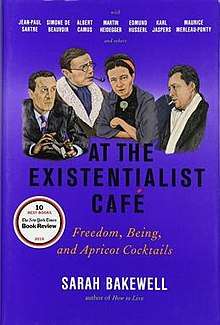At the Existentialist Cafe
At the Existentialist Cafe: Freedom, Being, and Apricot Cocktails is a 2016 book written by Sarah Bakewell that covers the philosophy and history of the 20th century movement existentialism.[1] The book provides a very accurate account of the modern day existentialists who came into their own before and during the second world war. The book discusses the ideas of the phenomenologist Edmund Husserl, and how his teaching influenced the rise of existentialism through the likes of Martin Heidegger, Jean Paul Sartre, Simone De Beauvoir, who are the main protagonists of the book. The title refers to an incident in which Sartre's close friend and fellow philosopher Raymond Aron startled him when they were in a cafe, by pointing to the glass in front of him and stating, "You can make a philosophy out of this cocktail."
 Cover | |
| Author | Sarah Bakewell |
|---|---|
| Illustrator | Andreas Gurewich |
| Country | United States |
| Language | English |
| Subject | Existentialism |
| Publisher | Other Press |
Publication date | 2016 |
| Media type | Print (Hardcover and Paperback) |
| Pages | 448 |
| ISBN | 978-1590514887 |
Summary
Bakewell structures At the Existentialist Cafe by focusing each chapter on a particular philosopher or period within the existentialist movement, starting by introducing the early existentialists Kierkegaard, Nietzsche, Dostoevsky and Kafka, and then moving onto the lives and philosophies of Heidegger, Husserl, Sartre, Beauvoir, Camus, Karl Jaspers, and Merleau-Ponty.
Bibliography
- Bakewell, Sarah (2016). At the Existentialist Cafe: Freedom, Being, and Apricot Cocktails (1st ed.). New York, New York: Other Books.
- Hussey, Andrew (28 February 2016). "At the Existentialist Café: Freedom, Being, and Apricot Cocktails by Sarah Bakewell – review". The Guardian. The Guardian. Retrieved 13 January 2018.
- Maslin, Janet (2 March 2016). "Review: In Sarah Bakewell's 'At the Existentialist Café,' Nothingness Has a Certain Something". The New York Times. The New York Times. Retrieved 13 January 2018.
- Golson, Richard. "Life and Death at the Existentialist Café - Los Angeles Review of Books". Los Angeles Review of Books. LA Review of Books. Retrieved 13 January 2018.
- Long, Karen (4 March 2016). "The existentialists come alive (over cocktails) in Sarah Bakewell's 'At the Existentialist Cafe'". Los Angeles Times. LA Times. Retrieved 13 January 2018.
- Grey, John. "Being Human". Literary Review. Literary Review.
- Coyne, John R. "BOOK REVIEW: 'At the Existentialist Cafe: Freedom, Being, and Apricot Cocktails'". The Washington Times. The Washington Times. Retrieved 13 January 2018.
Footnotes
- Bakewell, Sarah (2016). At the Existentialist Cafe: Freedom, Being, and Apricot Cocktails (1st ed.). New York, New York: Other Books.